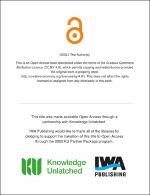Methods for Faecal Sludge Analysis
Contributor(s)
Velkushanova, Konstantina (editor)
Brdjanovic, Damir (editor)
Koottatep, Thammarat (editor)
Strande, Linda (editor)
Buckley, Chris (editor)
Ronteltap, Mariska (editor)
Collection
Knowledge Unlatched (KU)Language
EnglishAbstract
Faecal sludge management is recognized globally as an essential component of city-wide inclusive sanitation. However, a major gap in developing appropriate and adequate management and monitoring for faecal sludge is the ability to understand and predict the characteristics and volumes of accumulated faecal sludge, and correlations to source populations. Since standard methods for sampling and analysing faecal sludge do not currently exist, results are not comparable, the actual variability is not yet fully understood, and the transfer of knowledge and data between different regions and institutions can be challenging and often arbitrary. Due to this lack of standard analytical methods for faecal sludge, methods from other fields, such as wastewater management, and soil and food science are frequently applied. However, these methods are not necessarily the most suitable for faecal sludge analysis, and have not been specifically adapted for this purpose. Characteristics of faecal sludge can be different than these other matrices by orders of magnitude. There is also a lack of standard methods for sampling, which is complicated by the difficult nature of in situ sampling, the wide range of onsite sanitation technologies and potential sampling locations, and the diverse heterogeneity of faecal sludge within onsite containments and within cities. This illustrates the urgent need to establish common methods and procedures for faecal sludge characterisation, quantification, sampling, and modelling. The aim of this book is to provide a basis for standardised methods for the analysis of faecal sludge from onsite sanitation technologies, for improved communication between sanitation practitioners, and for greater confidence in the generated data. The book presents background information on types of faecal sludge, methods for sample collection, health and safety procedures for handling, case studies of experimental design, an approach for estimating faecal sludge at community to city-wide scales, modelling containment and treatment processes, recipes for simulants, and laboratory methods for faecal sludge analysis currently in use by faecal sludge laboratories. This book will be beneficial for researchers, laboratory technicians, academics, students and sanitation practitioners.
Keywords
Technology & Engineering; Environmental; Waste ManagementDOI
https://doi.org/10.2166/9781780409122ISBN
9781780409122, 9781780409122Publisher
IWA PublishingPublisher website
https://www.iwapublishing.com/Publication date and place
2021Imprint
IWA PublishingClassification
Waste treatment & disposal
Waste treatment and disposal


 Download
Download